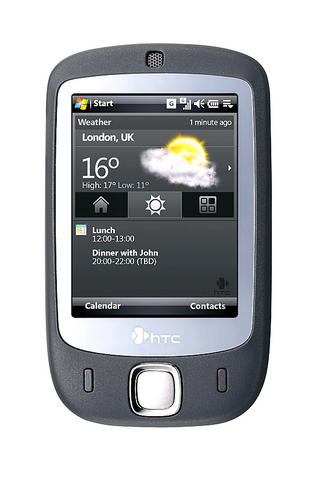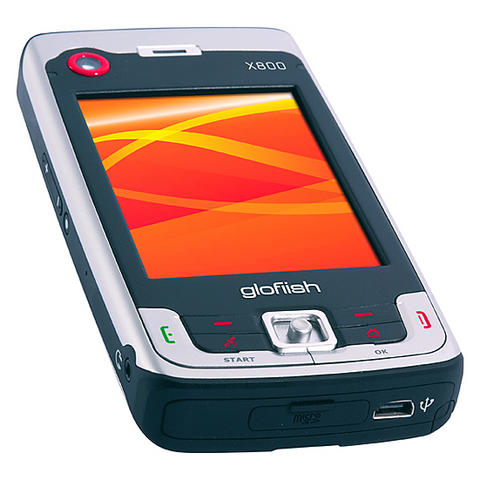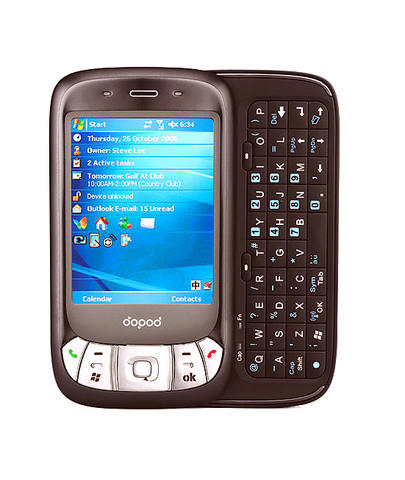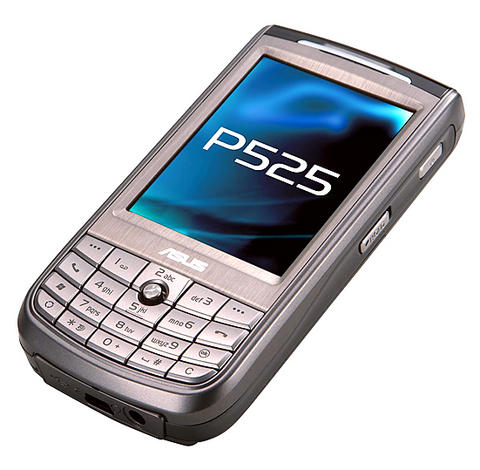After months of sweaty-palmed anticipation, the iPhone has finally landed. However, unless you live in the US and subscribe to AT&T you are sadly out of luck - you can't buy one. But are there any alternatives if you can't wait?
Taipei-based HTC believes there is. The organization, until recently branded Dopod in Taiwan's domestic market, is now rolling out globally under the corporation's original moniker, and the Touch is its first product. As such, a lot is riding on the cell phone's successful reception.
The spec sheet is comparable to the iPhone - a big touch screen, camera, mobile e-mail, and a keyboard that is notable only by its absence. It runs the very latest variant of Windows Mobile, so the guys at Microsoft will also be watching this product launch with particular interest.

It's difficult not to be impressed by the Touch's diminutive size, rounded form, rubbery paint and neat design details, such as the way the status LEDs are placed behind the speaker grille. Ignoring the cheap-looking chrome trim from around the camera, it's clear that this is the company's most concerted attempt yet to break out of the business device field - it is very good looking, and is already a hit with the girls in the office.
HTC's Industrial Designer, Francois Bellet-Odent, said the collection of rocks and pebbles scattered around his Taipei office were referenced when designing the phone's form. Considerable design and engineering effort was focused on removing the step between the case of the phone and the screen, which would ruin the otherwise very soft form - something that plagues most touch screen devices.
The big news, however, is the update to the user interface, dubbed TouchFlo. The first element is a remodeled home screen that is a replacement for the regular Windows display. It's a big improvement, and presents the user with large, nicely drawn buttons for composing new messages, checking the weather or checking for missed calls - and it even tells the time. Apple's influence is plain to see, but it is no less attractive for that.

The second is the TouchCube UI, which forms the basis of HTC's advertising effort. Essentially, it's a flashy program launcher that allows the user to access the most important applications using one hand alone. It's activated by swiping your thumb or finger up the screen, and then you spin the "cube" sideways to see one of three views - your most important contacts, media and photos, and applications.
More astute readers will be wondering why the cube only has three sides, and unfortunately this is not the product's only slipup. The touch screen is not very responsive and requires a surprising degree of pressure to encourage it to work properly, and if the screen is anything close to being free of grease the user's finger stutters across. None too smooth.
When it works, flipping between the three panels is quite fun, right up until the point when you need to do anything useful like write an SMS, when you are ejected, naked and shivering, back into the world of Windows Mobile. There is then no choice but to slide out the stylus and begin poking away at the on-screen keyboard, squinting at the tiny characters. The Internet experience is even worse: pages load in entirely unexpected ways, and scrolling side-to-side trying to read an article quickly becomes frustrating.

Despite its flaws the Touch still impresses. If you are a committed Windows Mobile user looking for something more pocket-sized, unimpressed by the LG Prada phone's cynical branding, or cannot bear to wait until Apple's baby reaches these shores, this may be the phone for you. But an iPhone it is not.
NT$15,900; Stores nationwide; Available now
Taiwan's other contenders:

PHOTO: COURTESY OF ASUS
Glofiish X800
Cell phones are packing more and more equipment into ever-smaller packages. The Glofiish X800 is a case in point, and loads GPS (unlike the iPhone) and WiFi into its flashy looking exterior. The name is strange, but the design and engineering seem solid - it won the Best of Computex award this year.
NT$27,000; Available fall 2007
Asus P525
The Asus P525 employs a combination of a standard keypad with a touch screen, and looks rather similar to the Sony Ericsson P990i. It is aimed at the serious business user, and as a result looks pretty dull and grey. If you are going to have a keyboard at the base of the screen, you may as well have a bigger one, in the style of a Treo or Blackberry.
NT$16,900; PDA King; Available now
Dopod C800
Many people remain unconvinced that a touch screen for keyboard-intensive tasks, such as sending e-mail on the move, will work well. HTC have a number of models that slide open to reveal a generously big thumb keyboard but that are still small enough to slide into the pocket. The Dopod line is likely to get sidelined as the company shifts its focus to the Touch, so good deals may be available for this already established product in the future.
NT$19,999; Sogi.com; Available now
-- Jonathan Biddle is head of industrial design at DEM Inc, Taipei

Oct. 27 to Nov. 2 Over a breakfast of soymilk and fried dough costing less than NT$400, seven officials and engineers agreed on a NT$400 million plan — unaware that it would mark the beginning of Taiwan’s semiconductor empire. It was a cold February morning in 1974. Gathered at the unassuming shop were Economics minister Sun Yun-hsuan (孫運璿), director-general of Transportation and Communications Kao Yu-shu (高玉樹), Industrial Technology Research Institute (ITRI) president Wang Chao-chen (王兆振), Telecommunications Laboratories director Kang Pao-huang (康寶煌), Executive Yuan secretary-general Fei Hua (費驊), director-general of Telecommunications Fang Hsien-chi (方賢齊) and Radio Corporation of America (RCA) Laboratories director Pan
The consensus on the Chinese Nationalist Party (KMT) chair race is that Cheng Li-wun (鄭麗文) ran a populist, ideological back-to-basics campaign and soundly defeated former Taipei mayor Hau Lung-bin (郝龍斌), the candidate backed by the big institutional players. Cheng tapped into a wave of popular enthusiasm within the KMT, while the institutional players’ get-out-the-vote abilities fell flat, suggesting their power has weakened significantly. Yet, a closer look at the race paints a more complicated picture, raising questions about some analysts’ conclusions, including my own. TURNOUT Here is a surprising statistic: Turnout was 130,678, or 39.46 percent of the 331,145 eligible party

The classic warmth of a good old-fashioned izakaya beckons you in, all cozy nooks and dark wood finishes, as tables order a third round and waiters sling tapas-sized bites and assorted — sometimes unidentifiable — skewered meats. But there’s a romantic hush about this Ximending (西門町) hotspot, with cocktails savored, plating elegant and never rushed and daters and diners lit by candlelight and chandelier. Each chair is mismatched and the assorted tables appear to be the fanciest picks from a nearby flea market. A naked sewing mannequin stands in a dimly lit corner, adorned with antique mirrors and draped foliage

The election of Cheng Li-wun (鄭麗文) as chair of the Chinese Nationalist Party (KMT) marked a triumphant return of pride in the “Chinese” in the party name. Cheng wants Taiwanese to be proud to call themselves Chinese again. The unambiguous winner was a return to the KMT ideology that formed in the early 2000s under then chairman Lien Chan (連戰) and president Ma Ying-jeou (馬英九) put into practice as far as he could, until ultimately thwarted by hundreds of thousands of protestors thronging the streets in what became known as the Sunflower movement in 2014. Cheng is an unambiguous Chinese ethnonationalist,